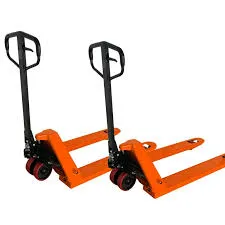


Understanding Pallet Truck Types A Comprehensive Guide
Pallet trucks, often referred to as pallet jacks, are essential tools in warehouses, distribution centers, and manufacturing plants. They facilitate the movement of goods and materials, optimizing the workflow and increasing efficiency. There are several types of pallet trucks, each designed for specific applications and environments. Understanding the various types can help businesses choose the right equipment for their needs, enhancing productivity and ensuring safety.
1. Manual Pallet Trucks
Manual pallet trucks are the most common and widely used type in various industries. These devices rely on human power for operation and are used primarily for lifting and transporting pallets. They typically feature a simple design with a set of forks that slide under the pallet, allowing the operator to lift the load with a hydraulic pump. Manual pallet trucks are best suited for light to medium-duty applications where heavy lifting is not a necessity. They can maneuver tight spaces effectively and are relatively inexpensive, making them a popular choice for small businesses and retail environments.
2. Electric Pallet Trucks
For operations that require higher efficiency and reduced labor intensity, electric pallet trucks offer an excellent solution. These powered devices are equipped with electric motors that assist in lifting and moving heavy loads, making them ideal for warehouses that handle large volumes of goods. Electric pallet trucks come in two forms walk-behind and ride-on. Walk-behind models allow the operator to guide the truck while standing alongside it, while ride-on models enable operators to sit within the truck for greater comfort during long-distance transport. These trucks are particularly advantageous in larger warehouses, as they reduce fatigue and improve productivity.
3
. High-Lift Pallet Trucks
High-lift pallet trucks, as the name suggests, can lift pallets to a greater height compared to standard manual and electric models. These devices are particularly useful in environments where lifting goods to higher shelves is required. High-lift trucks combine the functions of a pallet jack and a lift table, allowing for both transportation and elevated handling of pallets. This makes them an excellent choice for assembly lines or distribution centers where products need to be accessed at various heights.
4. Rough Terrain Pallet Trucks
For outdoor applications or rugged environments, rough terrain pallet trucks are specifically designed to handle uneven surfaces. These trucks usually feature all-terrain wheels and enhanced structural stability, making them capable of navigating gravel, dirt, and slopes without compromising performance. Rough terrain pallet trucks are commonly used in construction sites or agricultural settings, where conventional pallet jacks may falter. Their robust build provides the durability needed to transport heavy loads in challenging conditions.
5. Stainless Steel Pallet Trucks
In industries that require strict hygiene standards, such as food processing or pharmaceuticals, stainless steel pallet trucks are preferred. These models are designed to resist corrosion and contamination, making them ideal for environments where cleanliness is paramount. Stainless steel offers durability and ease of cleaning, ensuring that businesses can maintain sanitary conditions while transporting goods. These trucks are available in both manual and electric variants to suit different operational needs.
Conclusion
Choosing the right type of pallet truck is crucial for optimizing workflow and enhancing safety in material handling operations. Businesses must assess their specific needs, considering factors such as load weight, surface conditions, and operational scale. By understanding the different types of pallet trucks available—manual, electric, high-lift, rough terrain, and stainless steel—companies can make informed decisions that improve efficiency and productivity while meeting industry standards and safety regulations. Investing in the appropriate equipment not only streamlines operations but also contributes to a safer and more effective work environment.



